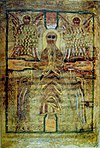Durham Dean and Chapter Library
| Durham Dean and Chapter Library | |
|---|---|
 | |
 | |
| 54°46′24″N 1°34′32″W / 54.77333189686748°N 1.5756732695219298°W | |
| Location | Durham, England |
| Established | 995 |
| Other information | |
| Affiliation | Durham Cathedral |
| Website | https://www.durhamcathedral.co.uk/explore/treasures-collections/cathedral-library |

The Durham Dean and Chapter Library, also known as Durham Cathedral Library, is located in Durham Cathedral, Durham, England. Founded in 995 AD, it is one of the largest English cathedral libraries. William de St-Calais donated 46 books.[1] In the 19th century it was located in the Old Frater House, or Monk's Hall, on the south side of the cathedral's cloisters, situated there in 1680 by the Dean of Durham John Sudbury, who fitted up the building.[2]
Holdings
[edit]There are 75,000 volumes and 60 incunabula. Of the 2,000 manuscripts, 360 are of the medieval era. The special collections contain early music.[3]
- Christian writings
The Durham Gospels, a very incomplete late 7th century insular Gospel Book (MS A. II. 17), and the Durham Gospel Fragment, a very incomplete late 7th century insular Gospel Book, are part of the library's holdings.[4]
There is also a copy of the Bible in four volumes, folio, which is 600 years old.[2] A copy of a manuscript describing the life of St Catherine of Alexandria was located in the library in the 12th century.[5]
- History
Five history books by the Venerable Bede are in the library.[2] The library houses three copies of the Magna Carta, including one dated 12 November 1216, and another dated 11 February 1224. The papers of George Allan, Christopher Hunter, Joseph Barber Lightfoot, James Raine, Ian Ramsey, Thomas Randall, Sir Cuthbert Sharp, and Robert Surtees are also part of the collections.[1]
References
[edit]- ^ a b Stam, David H. (1 November 2001). International dictionary of library histories. Taylor & Francis. pp. 298–. ISBN 978-1-57958-244-9. Retrieved 16 March 2012.
- ^ a b c Parson, William; White, William (1827). History, Directory, and Gazetteer, of the Counties of Durham and Northumberland: and the towns and counties of Newcastle-upon-Tyne and Berwick-upon-Tweed. Together with Richmond, Yarn, and detached places appertaining to the bishopric and palatinate of Durham; including copious lists of the seats of nobility and gentry, and a variety of commercial, agricultural, & statistical information ... (Public domain ed.). Printed for W. White & Co. by E. Baines and Son. pp. 171–. Retrieved 16 March 2012.
- ^ Crosby, Brian (May 1974). "Durham Cathedra's Music Manuscripts". The Musical Times. 115 (1575): 418–421. doi:10.2307/959081. JSTOR 959081. Retrieved 29 November 2022.
- ^ "Durham Cathedral Library". Durham World Heritage Site. Retrieved 29 November 2022.
- ^ Holt, J. C. (1990). Domesday studies: papers read at the Novocentenary Conference of the Royal Historical Society and the Institute of British Geographers, Winchester, 1986. Boydell & Brewer. pp. 74–. ISBN 978-0-85115-263-9. Retrieved 16 March 2012.
